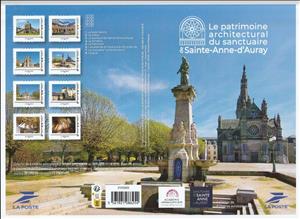Souvenir Sheet: Architectural Heritage of Saint-Anne-d'Auray (France 2025)
Architectural Heritage of Saint-Anne-d'Auray (France 2025)
16 June (France ) within release Collector : Architectural Heritage of Saint-Anne-d'Auray goes into circulation Souvenir Sheet Architectural Heritage of Saint-Anne-d'Auray face value 8*Lettre No Face Value
| Souvenir Sheet Architectural Heritage of Saint-Anne-d'Auray in catalogues | |
|---|---|
| Colnect codes: | Col: FR-COL 2025-24 |
Souvenir Sheet is square format.
Also in the issue Collector : Architectural Heritage of Saint-Anne-d'Auray:
- Stamp - Academy of Sacred Music and Art Saint-Anne-d'Auray face value Lettre;
- Souvenir Sheet - Architectural Heritage of Saint-Anne-d'Auray face value 8*Lettre;
- Stamp - Basilica Saint-Anne-d'Auray face value Lettre;
- Stamp - Fountain Saint-Anne-d'Auray face value Lettre;
- Stamp - Memorial Saint-Anne-d'Auray face value Lettre;
- Stamp - Model of 'La Sainte Anne' Saint-Anne-d'Auray face value Lettre;
- Stamp - Organ Saint-Anne-d'Auray face value Lettre;
- Stamp - Saint-Anne-d'Auray Cloister face value Lettre;
- Stamp - Saint-Anne-d'Auray Scala Sancta / Holy Ladder face value Lettre;
Souvenir Sheet Architectural Heritage of Saint-Anne-d'Auray it reflects the thematic directions:
Architecture (Latin architectura, from the Greek ἀρχιτέκτων arkhitekton "architect", from ἀρχι- "chief" and τέκτων "builder") is both the process and the product of planning, designing, and constructing buildings and other physical structures. Architectural works, in the material form of buildings, are often perceived as cultural symbols and as works of art. Historical civilizations are often identified with their surviving architectural achievements.
A church building, often simply called a church, is a building used for Christian religious activities, particularly worship services. The term in its architectural sense is most often used by Christians to refer to their religious buildings, but it is sometimes used (by analogy) for buildings of other religions. In traditional Christian architecture, the church is often arranged in the shape of a Christian cross. When viewed from plan view the longest part of a cross is represented by the aisle and the junction of the cross is located at the altar area. Towers or domes are often added with the intention of directing the eye of the viewer towards the heavens and inspiring church visitors. Modern church buildings have a variety of architectural styles and layouts; many buildings that were designed for other purposes have now been converted for church use; and, similarly, many original church buildings have been put to other uses. The earliest identified Christian church was a house church founded between 233 and 256. During the 11th through 14th centuries, a wave of building of cathedrals and smaller parish churches occurred across Western Europe. A cathedral is a church, usually Roman Catholic, Anglican, Oriental Orthodox or Eastern Orthodox, housing the seat of a bishop.
A fountain, from the Latin "fons" (genitive "fontis"), meaning source or spring, is a decorative reservoir used for discharging water. It is also a structure that jets water into the air for a decorative or dramatic effect.
A monument is a type of structure that was explicitly created to commemorate a person or event, or which has become relevant to a social group as a part of their remembrance of historic times or cultural heritage, due to its artistic, historical, political, technical or architectural importance. Examples of monuments include statues, (war) memorials, historical buildings, archaeological sites, and cultural assets. If there is a public interest in its preservation, a monument can for example be listed as a UNESCO World Heritage Site. The Palgrave Encyclopedia of Cultural Heritage and Conflict gives the next definition of monument:
A musical instrument is a device created or adapted to make musical sounds. In principle, any object that produces sound can be considered a musical instrument—it is through purpose that the object becomes a musical instrument. A person who plays a musical instrument is known as an instrumentalist. The history of musical instruments dates to the beginnings of human culture. Early musical instruments may have been used for rituals, such as a horn to signal success on the hunt, or a drum in a religious ceremony. Cultures eventually developed composition and performance of melodies for entertainment. Musical instruments evolved in step with changing applications and technologies.
A university (from Latin universitas 'a whole') is an institution of higher (or tertiary) education and research which awards academic degrees in several academic disciplines. University is derived from the Latin phrase universitas magistrorum et scholarium, which roughly means "community of teachers and scholars". Universities typically offer both undergraduate and postgraduate programs.





